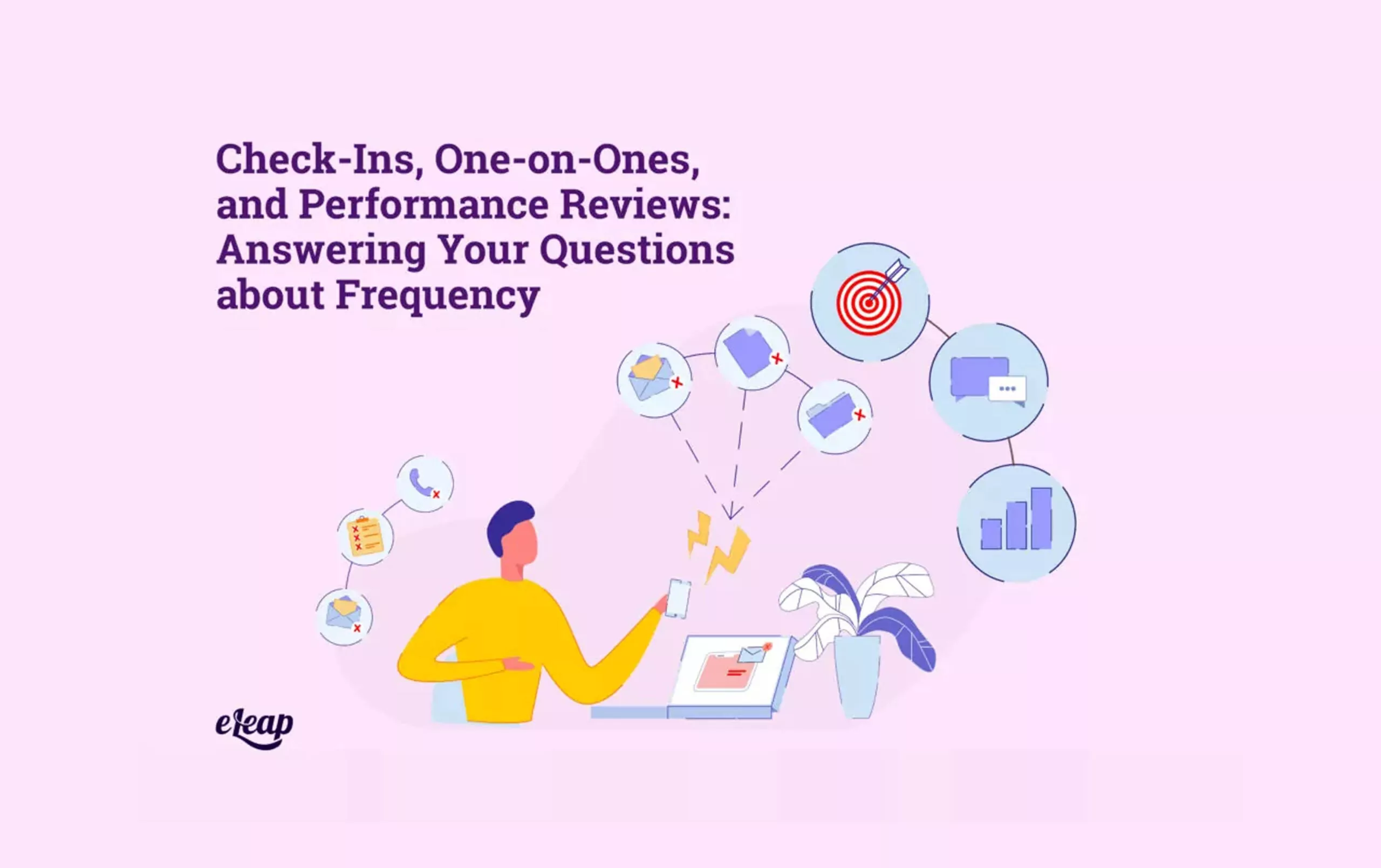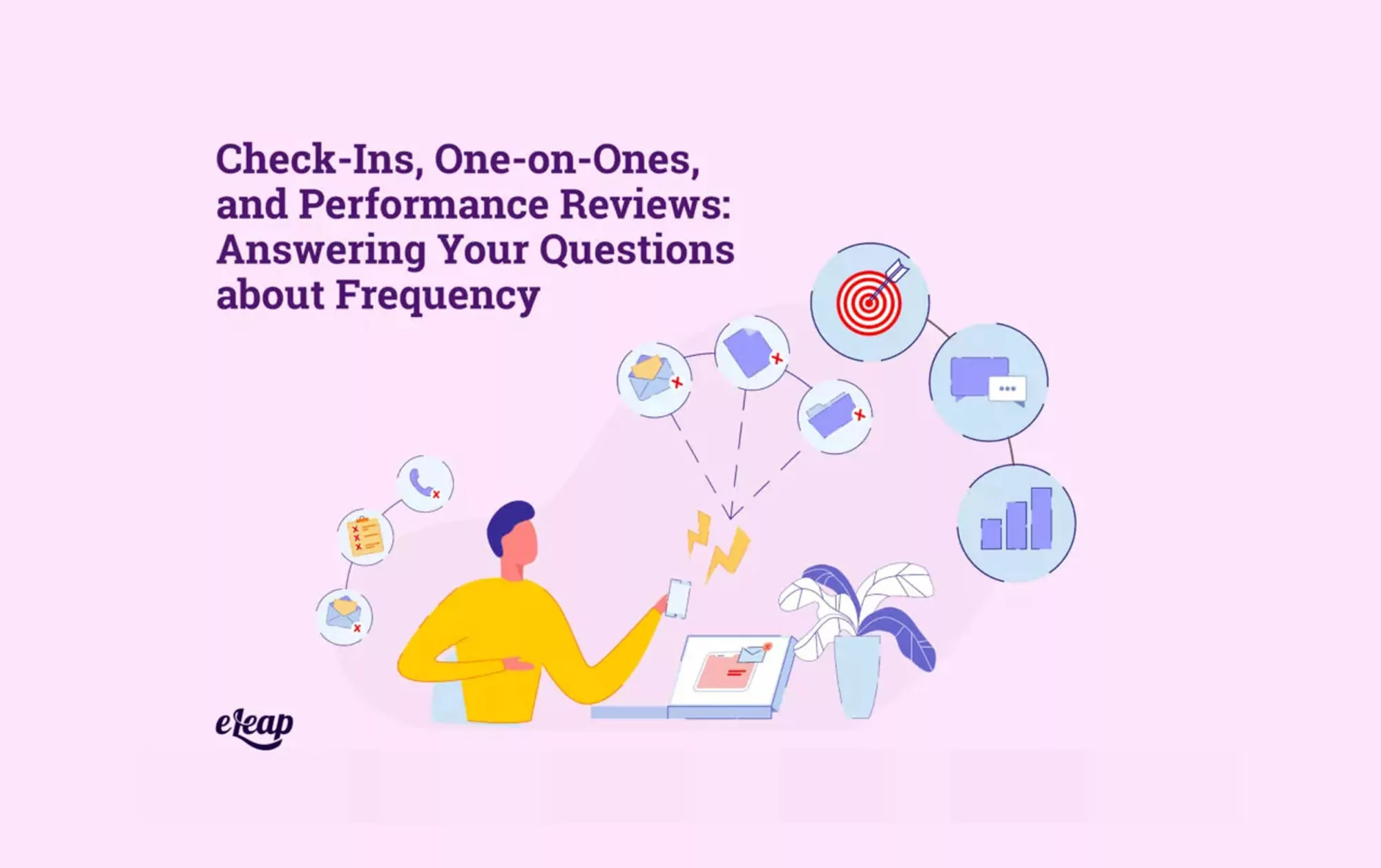Check-Ins, One-on-Ones, and Performance Reviews: Answering Your Questions about Frequency

Performance management is something of a balancing act. It involves check-ins, One-on-ones, reviews, feedback, and more. Managers and other leaders must provide actionable feedback so that employees can change their behavior for the better but they must do so in a way that is both timely and not overbearing. There’s also the fact that providing such feedback is just one of their responsibilities. Explore how eLeaP’s Performance Management Platform can simplify evaluations, boost productivity, and drive measurable results.
What is the right schedule? What should be provided when? Is there such a thing as too much feedback or too many check-ins, one-on-ones, and performance reviews? It can be daunting to strike the right balance, but it is possible. This post will discuss some important strategic tips to help ensure that your leaders can deliver critical feedback in time for employees to make meaningful changes without overloading their already busy schedules.

The Real Point of Performance Management
Really, it all comes down to understanding the true point of performance management. It’s not about punishing or “catching” people behaving badly. It’s not punitive at all, in fact.
The point of performance management is about observing behavior that does not lead to optimal outcomes and then providing feedback that changes the situation. It is also about recognizing when employees consistently do the right thing and encouraging desired behavior. So, the golden rule to follow when it comes to the frequency of PM-related activities is this:
Follow the frequency that works for each situation.
That might sound a little ambiguous, but when we unpack it, things become simpler to understand. It is really all about being observant and identifying the needs and challenges of your team members. When you can do that, everything else falls into place.
Establishing Your Frequency
To establish the frequency of your PM-related activities, you will need to drill down into several specific areas. We’ll address those below.
Set a Baseline
The first thing you must do is set a baseline for your PM-related activities. How often will you conduct full performance reviews? What about one-on-ones? Informal check-ins?
There is no “right” answer here. What works for your team may not work for another. Determine your baseline frequency using specific criteria, such as:
- Industry: Some industries are much faster-paced than others, and you’ll need a frequent feedback schedule to ensure that your team keeps up with the rate of change.
- Audience: Is your audience more demanding? Do your clients expect more than another business’s? In that case, you’ll want to account for that in your performance management efforts.
- Business: Consider your own corporate culture. Some companies work well with a more hands-off approach, while others thrive with the opposite strategy. Know your business and set the appropriate baseline.
The Average
If you find it challenging to set a baseline, you can follow the “average”. Most businesses today have done away with the annual performance review. Instead, they provide a formal review every six months. That is augmented by check-ins and one-on-ones, often conducted every month or so. Note that this is a relatively generic average and you should ideally customize it to your business’s specific requirements.
Observe and Adjust
Once you have your baseline in place, you at least have that to fall back on. However, there is more that you must do. Observe your employees – do you notice some struggling to maintain performance goals? Do some of your people seem to veer off course over time?
In these cases, you will need to increase the frequency of your performance management-related touchpoints. Think of it as providing a map and your check-ins, one-on-ones, and performance reviews are pins that show employees where they need to go. The more pins in the map, the more easily employees will be able to tell where they need to go. Conversely, fewer pins can mean that employees take undesirable paths or even double back the way they came without realizing it.
In a way, performance management really is all about giving employees the most accurate map to the desired destination.
However, it is also important to realize that there’s no one-size-fits-all approach when it comes to mapping out employee performance routes. Everyone is different. One employee might thrive with a check-in every month or two and no other inputs. Another employee might need to have weekly one-on-ones. The other metrics we discussed (business culture, audience, industry) will also play a role here.
The Benefits of More Frequent Feedback Sessions
Whether it’s a check-in, a one-on-one, or a formal performance review, the point is to provide accurate, actionable feedback. Both of those go out the window with unrealistic timescales. That is one reason that the annual performance review is being abandoned – it simply doesn’t provide employees with a realistic opportunity for course correction.
Instead, it has become important to provide frequent feedback so that employees can correct their course as soon as possible. Putting more pins in the map helps ensure that employees can see the route clearly and if they deviate from it, they can quickly find it again with a minimum of lost time and hassle. It is not just about easier way-finding, though. Businesses stand to reap significant benefits from more frequent feedback sessions, including:
- Improved employee engagement
- Reduced employee and manager stress
- Improved alignment between employee goals and the company’s mission
- Leaders have a better grasp of employee performance over time
- Improved customer satisfaction and experience
Those are critical goals for most organizations, and simply stepping up the rate of your performance management-related efforts can be the key to achieving them. Finding the right mix of check-ins, one-on-ones, and more formal performance reviews will take a little time and some strategy, but the rewards are definitely worth the investment.
Closing Thoughts
Increasing the frequency of PM-related touchpoints is critical to achieving the organization’s goals and supporting your team members. However, the right tools and technology are critical here. The right performance management system can help you connect the dots for managers and employees, and create an easy-to-follow map that takes you from where you are now to where you need to be.